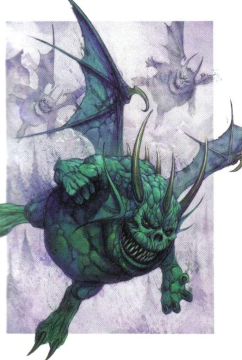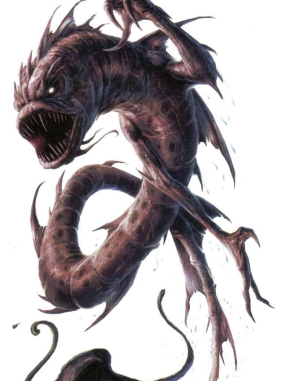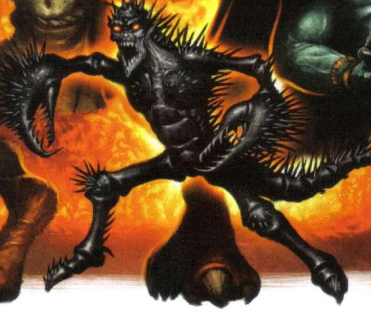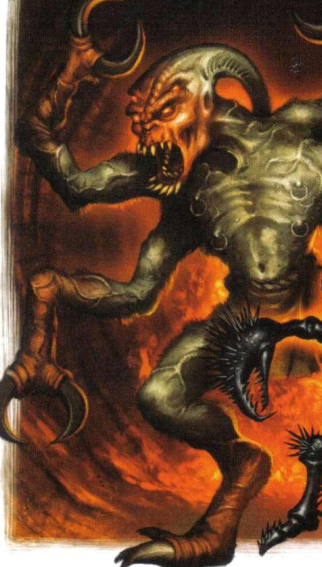Let's Read the 4e Monster Manual 2: Demons, Part 2
This is part of a series! Go here to see the other entries.
Continuing with the “Demon” entry of the Monster Manual 2, let’s look at a few more abyssal greeblies.
Gnaw Demon

These round boys live to eat. Their hunger is insatiable and they’re always gnawing on and eating everything around them. That sentence is quite literal too: they can eat anything, so they eat everything, all the time. Being demons, of course, they prefer living flesh above all else.
Despite this, gnaw demons are also quite cowardly and will run away if they see they’ve bitten off more than they can chew. Tracking them down isn’t too difficult, though, since they’ll soon become distracted by some other weak-looking target.
Gnaw demons can teleport, but it’s apparently a reflex not under their conscious control. Though they’ll likely avoid the thick of the fight at first, the smell of blood drives them into a frenzy.
The Numbers
Gnaw Demons are Small Elemental Humanoids, and Level 5 Skirmishers with 66 HP. They have Darkvision and are slow and blobby with a ground speed of 3 and a flight speed of 5 (clumsy). They have Variable Resistance 10 (1/encounter).
In combat they’re all about biting, since they’re pretty much trying to eat you. Their Ankle Biter aura (1) inflicts a -2 penalty to the speed of any enemy caught inside. Their basic attack is the obvious bite, which deals extra damage to bloodied enemies.
That reflexive teleport is modeled with two different abilities: Hungry Teleport (move action) allows the demon to teleport 10 squares into a square adjacent to a bloodied enemy. Pain-Induced Teleport (free action when first bloodied) is an unrestricted 10-square teleport, which it will likely use to flee.
Impressions
I kinda like these critters. They’re more flavorful than evistros (which smoulder with generic rage), though they also pair really well with them or other front-liners that can get the enemy bloodied so they can teleport in.
The sample encounter is Level 6 and has three of these spherical terrors accompanying a pair of gnolls.
Kazrith

Kazriths are barracuda-like aquatic demons that prowl the watery bodies of the abyss and might be summoned to do so elsewhere. Despite their preference for water they’re also perfectly capable of operating on land, so you don’t have to build an underwater dungeon in order to use them.
Though sapient, kazriths prefer to act as ambush predators, burying themselves in the ground and jumping out to attack anything that looks like it would be fun to kill. Their pores secrete strong acid, which helps both with the burrowing and with the killing.
They burrow as fast as they can run and leave stable tunnels behind, which means all bodies of water in kazrith territory are linked by networks of flooded tunnels. So if you do want to make an underwater dungeon, you have the perfect excuse.
The Numbers
Kazriths are Medium Elemental Magical Beasts with the Demon and Water keywords. Note that they don’t have Aquatic, so they don’t gain that +2 attack bonus when fighting underwater. They’re Level 20 Lurkers with 146 HP, an immunity to acid, and Variable Resistance 20 (2/encounter). They have a ground speed of 6, a burrow speed of 6 with Tunneling, and a swim speed of 8.
Their basic attack is a bite that also deals 5 ongoing acid damage (save ends). They can also burrow back into the ground while spraying acid behind them: this Acidic Retreat (recharge 5-6) is a close burst 2 vs. Refles, deals light physical damage, and 10 ongoing acid damage (save ends). It also allow the demon to burrow its speed as an effect.
When bloodied, its Acidic Seepage increases, causing it to gain +4 burrow speed and deal 10 acid damage to enemies that start their turn adjacent to the kazrith. Its Slippery trait allows it to make extra saves against the immobilized, slowed and restrained conditions at the start of its turn.
Fighting a kazrith is like playing a corrosive game of whack-a-mole, as it will keep burrowing back and popping up to bite you, and it’s hard to pin down.
Sample Encounters and Impressions
The sample encounter is Level 18 and features an Evil Party of aboleths, their minion servitors, and a pair of kazriths.
Kazriths sound like something that should logically exist, but by themselves they don’t really stoke my imagination. They do make decent additions to adventures featuring varied demons as opposition, and they work well with Aboleths.
Needle Demon

These prickly assholes love seeing former friends and allies turn on each other with murderous intent, particularly when they were the ones who instigated it. They’re much smarter than they look and often end up as advisors to more powerful villains, sometimes even as the power behind the throne. However, their lust for infighting often gets the better of them, so these deceptions never last long and cause terrible damage when they collapse.
The Numbers
Needle demons are Medium Elemental Humanoids (demons), and Level 12 Controllers with 123 HP. They have darkvision and Variable Resistance 15 (2/encounter). They run with speed 6.
They fight with their pincers and spiked tail. The claw attack is pretty standard, and Claws of Betrayal allows them to attack twice with them. If both attacks hit the same target, that target takes 10 ongoing damage (save ends). The Tail is a reaction attack that does light physical damage and is triggered by an enemy moving to a square adjacent to the demon.
Their most thematic power is Rage of the Betrayed (close blast 5 vs. Will; enemies only; recharge 6), which does no damage but dominates (save ends). Yes, it’s a mass dominate. It works by convincing the affected target that their allies have betrayed them, so I guess the demon is going to use it to make the PCs focus on fighting each other instead of itself.
The sample encounters have them working alongside gnolls and drow, but repeat that it never takes long for them to turn on their own allies.
Impressions
Simple, but quite effective due to that mass dominate. I’m guessing you could use a recurring needle demon NPC as a source of lots of drama, having it appear somewhere in every villainous group the PCs oppose only to always run away.
Neldrazu

These demons are into kidnapping, for which they use their four hooked claws. During a battle they like to hide around the edges and jump out to snatch an enemy and drag it either to an isolated spot or into the midst of the neldrazu’s allies. They’re often summoned by slavers who don’t mind if the goods are slightly damaged.
The Numbers
Neldrazu are Large Elemental Humanoids (demons) and Level 8 Lurkers with 71 HP. They have darkvision and Variable Resistance 10 (1/encounter). They have a ground speed of 8 and a climb speed of 6 with Spider Climb.
Their basic attack is a standard Claw, but when only one enemy is within 5 squares of the neldrazu they can really stretch and use Flaying Claws, which do double damage plus ongoing 5 damage (save ends). This means they’ll lurk until they can catch a PC alone, and then move in with this attack.
After using Flaying Claws, a neldrazu will likely follow it up with Abduct (recharge 5-6), a move action attack that targets Reflex and can only be used against enemies. It does no damage, but teleports the target 10 squares to a place of the demon’s choice on a hit. The demon teleports 10 squares right after this, either adjacent to the target on a hit, or to anywhere it chooses on a miss.
I think the best way to use this is to drop an enemy right in the middle of the neldrazu’s allies. If a lurker isolates itself with a PC, things tend to go poorly for the lurker.
Impressions
The Monster Manual 3 and later on the Monster Vault would include the Babau, a level 13 Skirmisher demon that’s quite similar, and which we covered here. At the time I remember poo-pooing the babau’s abduction tactics because I assumed it would always take the victim to an isolated place, but now I see it can also take them to its allies instead.
Compared to the babau, the neldrazu is a better team player, since it can abduct more often in a fight. Its special attack is quite situational, but it can be used before the abduction, which means it doesn’t have to choose between isolating a victim and bringing it to its allies.
End of Part 2
There’s at least one more post’s worth of demons to cover.